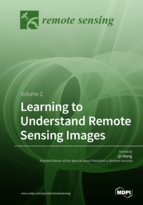Learning to Understand Remote Sensing Images
A special issue of Remote Sensing (ISSN 2072-4292). This special issue belongs to the section "Remote Sensing Image Processing".
Deadline for manuscript submissions: closed (31 December 2018) | Viewed by 320371
Special Issue Editor
Interests: remote sensing; image analysis; computer vision; pattern recognition; machine learning
Special Issues, Collections and Topics in MDPI journals
Special Issue Information
Dear Colleagues,
With the recent advances of remote sensing technologies for Earth observation, many different remote sensors are collecting data with distinctive properties. The obtained data are so large and complex that analyzing them manually becomes impractical or even impossible. For example, multi-source/multi-temporal/multi-scale data are frequently delivered by remote sensors. But, if we want to explore them by hand and then obtain useful information, the workload would be overwhelming and the performance would be unsatisfactory. Therefore, understanding remote sensing images effectively, in connection with physics, has been the primary concern of the remote sensing research community in recent years. For this purpose, machine learning is thought to be a promising technique because it can make the system learn to improve itself. With this distinctive characteristic, the algorithms will be more adaptive, automatic and intelligent.
In recent decades, this area has attracted a lot of research interest, and significant progress has been made in this direction, particularly in the optical, hyperspectral and microwave remote sensing communities. For instance, there have been several tutorials at various conferences that directly or indirectly correlate with machine learning topics, and numerous papers are published each year in top journals in the remote sensing community. Particularly, with the popularity of deep learning and big data concepts, research towards data learning and mining paradigms has reached new heights. The success of machine learning techniques lies in its practical effectiveness, improving current methods and achieving the state-of-the-art performance.
Nevertheless, there are still problems that need to be solved. For example, how to bring together the limited training samples available for deep learning related methods? How to adapt the original machine learning prototypes to remote sensing applications and particularly to physics? How to compromise between the learning speed and its effectiveness? Many other challenges remain in the remote sensing field which have fostered new efforts and developments to better understand remote sensing images via machine learning techniques.
This Collection on "Learning to Understand Remote Sensing Images" focuses on this topic. We invite original submissions reporting recent advances in the machine learning approaches towards analyzing and understanding remote sensing images, and aim foster an increased interest in this field.
This Collection will emphasize the use of state-of-the-art machine learning techniques and statistical computing methods, such as deep learning, graphical models, sparse coding and kernel machines.
Potential topics include, but are not limited to:
-
Optical, hyperspectral, microwave and other types of remote sensing data;
-
Feature learning for remote sensing images;
-
Learning strategies for multi-source/multi-temporal/multi-scale image fusion;
-
Novel machine learning and statistical computing methods for remote sensing;
-
Learning metrics on benchmark databases;
-
Applications such as classification, segmentation, unmixing, change detection, semantic labelling using the learning approaches.
Authors are requested to check and follow the specific Instructions to Authors, https://www.mdpi.com/journal/remotesensing/instructions.
We look forward to receiving your submissions.
Dr. Qi Wang
Collection Editor
Manuscript Submission Information
Manuscripts should be submitted online at www.mdpi.com by registering and logging in to this website. Once you are registered, click here to go to the submission form. Manuscripts can be submitted until the deadline. All submissions that pass pre-check are peer-reviewed. Accepted papers will be published continuously in the journal (as soon as accepted) and will be listed together on the special issue website. Research articles, review articles as well as short communications are invited. For planned papers, a title and short abstract (about 100 words) can be sent to the Editorial Office for announcement on this website.
Submitted manuscripts should not have been published previously, nor be under consideration for publication elsewhere (except conference proceedings papers). All manuscripts are thoroughly refereed through a single-blind peer-review process. A guide for authors and other relevant information for submission of manuscripts is available on the Instructions for Authors page. Remote Sensing is an international peer-reviewed open access semimonthly journal published by MDPI.
Please visit the Instructions for Authors page before submitting a manuscript. The Article Processing Charge (APC) for publication in this open access journal is 2700 CHF (Swiss Francs). Submitted papers should be well formatted and use good English. Authors may use MDPI's English editing service prior to publication or during author revisions.






